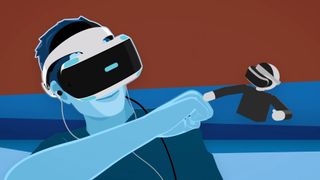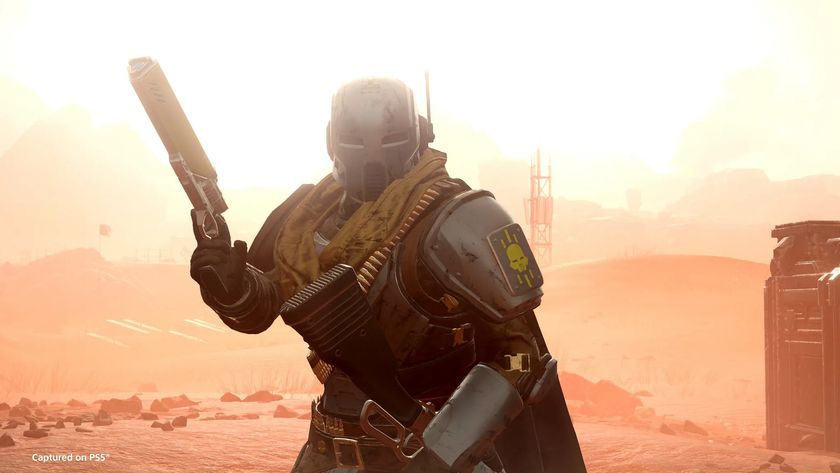L.A. Noire in virtual reality is a gently confusing miracle that poses big questions for Grand Theft Auto’s future
It's hard to escape the feeling that L.A. Noire in VR is a testbed for more exhilarating, and ethically complex, first-person experiences, with eyes on the future of GTA
Cole Phelps, former soldier and rookie investigator, has a case to solve that will lure him deep into Los Angeles’ criminal underbelly, and it all begins with the mystery of a wooden cylinder. A cylinder known as a pencil. Jabbing out a hand, he scrawls ‘ckooool’ – at least, that's how it looks, since the lead doesn't always leave a mark – on his notepad. Cole thinks hard about how to turn the page, and depresses his fingers, noting the satisfying buzz, before writing ‘hooelo’. Cole flicks his wrist to throw the pencil across the room. Surprised by the satisfying clunk as it lands on the far wall, he picks up a pencil sharpener from his desk and lobs it in the same direction. A heavier thud follows and he picks up a photo of his wife, his kids, a mug... wait, why is the pencil back again?… throwing objects faster than they can appear. Welcome to the slightly confusing world of L.A. Noire in virtual reality, an imperfect miracle of improvisation that poses big questions for all Rockstar games to follow.
- L.A. Noire for Nintendo Switch preview: Rockstar's crime drama deserves an encore, and Nintendo Switch is a perfect fit
- L.A. Noire: The VR Case Files preview: Why a VR version proves this dark detective story was ahead of its time
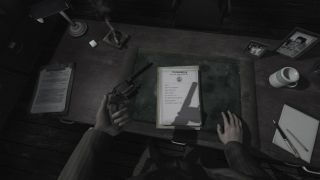
Hands up, I had no expectations for L.A. Noire on HTC Vive, and relatively little experience of virtual reality. I’d enjoyed the Star Wars Battlefront VR demo and its thrilling sense of scale, but the experience was more theme park ride than game. L.A. Noire, however, places you into a fractional alternate reality, where *almost* anything is possible, as plausible physics collide with the partially intuitive rules of controlling your own body. Wearing a headset, you’re transported into Cole’s office, and the pistol-like Vive controllers in both hands become his hands. The inset buttons become your grip command, and the analogue triggers control the shape of your fingers. It’s all context-sensitive, and when there’s no objects nearby, you can instruct your fingers to point and form circles.
It’s absurd, but in no time, you’re making circles with both hands, and improvising a pair of binoculars. In the most earnest interrogation scenes, you can lean into the suspect’s face, then step back and make a pair of finger spectacles while dancing on the spot. Or you can respond to a colleague’s request to leave a crime scene by shooting him with finger pistols and blowing them out. I mean, you can even pick up a cigar with one hand, a lighter in the other, and do that dismissive ‘bad cop’ stoop to light it up if you doubt what a suspect is saying. In Cole’s office, there’s a mirror where you can try on outfits, pop some more finger guns, then start dancing… with your actions almost, but not quite, reflected in-game.
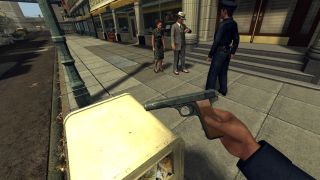
It’s compelling, but dislocating. Some actions, like picking up objects, looking around and throwing punches are nigh-on 1:1 mirrors of reality with natural movements. Others, like turning the page on your notepad, or running – more on that later – require a new mental taxonomy, like you’ve appeared on a Saturday night game show and need to prepare a cooked meal using a string puppet. Get into a fight in L.A. Noire, and you can authentically duck and dodge punches, or hold up your hands to block. Fail to swing your fist sufficiently forwards, however, and the blow fails to connect, so you get the unusual sensation of haymaking fresh air, even though the visuals suggest you should be making a connection. The result is that you’ve really got to exaggerate the blows, like a drama school rehearsal of Rocky.

I have to do… *what*… to drive the car?
Driving is even more amazing. You have to physically insert the key in the ignition, twist it, then use a combination of the finger triggers to accelerate, and your hands to steer. It really does feel like you’re behind the wheel, and I was wincing as I missed pedestrians by inches, or ran red lights. At one stage, I panicked as the car adopted the turning circle of a combine harvester at a sharp bend and I clattered into a fire hydrant… only to look down at my hands, to realise I’d taken one hand off the wheel and was making finger circles again. And, yes, you can cruise with one hand and finger shoot people out of the window with the other.
Movement faces the same challenges as most first-person VR games, like the upcoming version of Skyrim, with the most efficient way to travel being to look at a distant object until it glows and tapping a button to ‘teleport'. You watch your wireframe body walk ahead of yourself in first-person, before your consciousness snaps back into your body. You get used to it, but the juxtaposition of point-and-click leg movement with analogue upper body control is jarring. L.A. Noire does attempt a more natural solution: you can pump your arms to ‘run’, altering speed with the frequency of your movements. Amazingly, it almost works, and makes chasing suspects a genuinely physical thrill – although you sometimes find yourself veering off to the left or right, like you’re wearing a lead activity tracker, because your arm movements have become imbalanced, or your head is ever-so-slightly tilted to one side.
L.A. Noire feels like an entirely new game in virtual reality, and the juxtaposition of physical improvisation and po-faced crime noir ensures everyone should have a fun experience. No-one is forcing you to play the fool. Even played straight, investigating clues in a grizzly crime scene is much more engaging in VR, as you physically move bodies and inspect matchboxes stuffed in jacket pockets. It’s hard to escape the feeling, however, that L.A. Noire, with its 1940s setting, relatively quiet streets, slower pace, conversational focus, older vehicles and grounded combat, are a safe environment for a VR experiment.
Sign up to the 12DOVE Newsletter
Weekly digests, tales from the communities you love, and more
"As anyone who’s played GTA 5 in first-person will tell you, seeing the game’s less palatable possibilities through your own eyes, imparts a dizzying feeling of power and remorse."
Your mind starts really racing, when you imagine this sense of physicality, immersion and improvisation in the first-person world of Grand Theft Auto. How will it feel to dress like a gangster and swing through Beverly Hills making ‘important’ calls, pausing only to blow kisses or give pedestrians the thumbs up? At the other extreme, how will it feel to wield a baseball bat, ‘feeling’ the weight in your hands, and repeatedly clobbering a passerby who dared to nudge into you? As anyone who’s played GTA 5 in first-person will tell you, seeing the game’s less palatable possibilities through your own eyes, imparts a dizzying feeling of power and remorse. How real is too real? How will video-games address the ethics of our baser impulses?

Where do we go from here?
To be clear, Rockstar has announced nothing beyond L.A. Noire in terms of virtual reality, but with the technical possibilities of VR, and emergence of AR – with Apple tipped to push the tech hard in 2020 – it feels hard not to see this as a testing ground. How feasible is it that Rockstar could add VR elements to Red Dead Redemption 2? At this stage, probably unlikely. Might the unannounced GTA 6 be fully playable in VR? Slightly more plausible, but market and technical realities make a standalone spin-off, or sections of the game e.g. heist interiors, more likely candidates for full immersion. Is there a world in which Rockstar might dare to re-master Manhunt for this technology? It feels unthinkable… but the mind races.
Big ethical questions, technical challenges and potential real world legislation await, but there’s no denying that L.A. Noire in VR is an imperfect glimpse of what video-games might become. It’s probably the most invigorating, unusual, virtual experience I’ve had in years, despite the control limitations and suspicions of novelty. The tech is tantalisingly close, the cost less so (you’ll need to invest at least $1000-1500 to make the most of HTC Vive right now if you don’t already own a PC), and there’s an impending singularity of VR, AI and open worlds that might just make the current conversation about whether smart phones are a force for good or ill, feel like a throwback to the 1940s.
FGS Content Director. Former 12DOVE EIC, GTAVoclock host, and PSM3 editor; with - *counts on fingers and toes* - 20 years editorial experience. Loves: spreadsheets, Hideo Kojima and GTA.

Assassin's Creed Shadows was originally envisioned without Yasuke, but Ubisoft wanted the full feudal fantasy: "We were sort of making a stealth tank, and it didn't quite work"
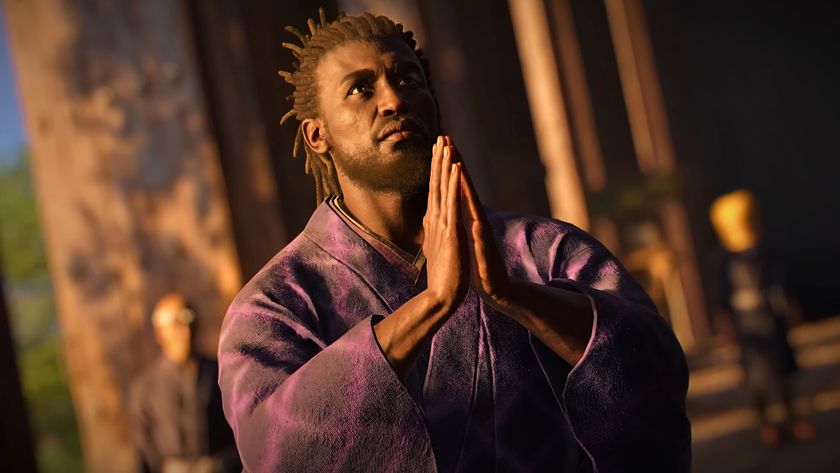
Assassin's Creed Shadows lead says dual protagonists are "a cool thing" the new action RPG "does better than what we've done in the past"
